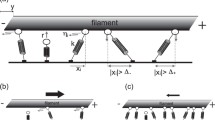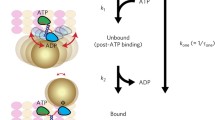Abstract.
Images, calculated from electron micrographs, show the three-dimensional structures of microtubules and tubulin sheets decorated stoichiometrically with motor protein molecules. Dimeric motor domains (heads) of kinesin and ncd, the kinesin-related protein that moves in the reverse direction, each appeared to bind to tubulin in the same way, by one of their two heads. The second heads show an interesting difference in position that seems to be related to the directions of movement of the two motors. X-ray crystallographic results showing the structures of kinesin and ncd to be very similar at atomic resolution, and homologous also to myosin, suggest that the two motor families may use mechanisms that have much in common. Nevertheless, myosins and kinesins differ kinetically. Also, whereas conformational changes in the myosin catalytic domain are amplified by a long lever arm that connects it to the stalk domain, kinesin and ncd do not appear to possess a structure with a similar function but may rely on biased diffusion in order to move along microtubules.
Similar content being viewed by others
Author information
Authors and Affiliations
Rights and permissions
About this article
Cite this article
Hirose, K., Amos, L. Three-dimensional structure of motor molecules. CMLS, Cell. Mol. Life Sci. 56, 184–199 (1999). https://doi.org/10.1007/s000180050421
Issue Date:
DOI: https://doi.org/10.1007/s000180050421




